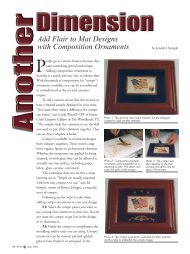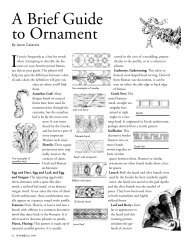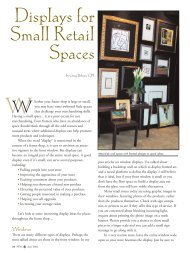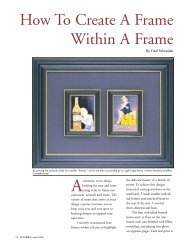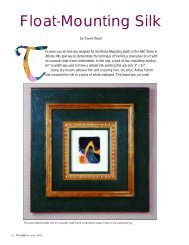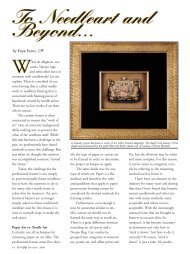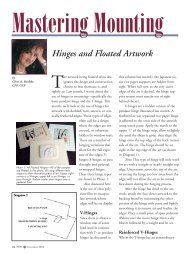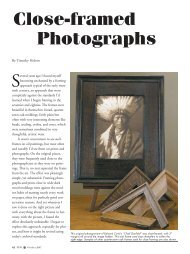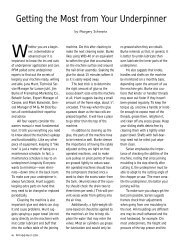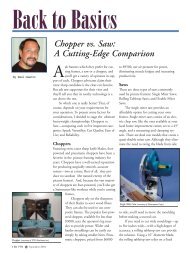Static Dispersing Glazing - Picture Framing Magazine
Static Dispersing Glazing - Picture Framing Magazine
Static Dispersing Glazing - Picture Framing Magazine
Create successful ePaper yourself
Turn your PDF publications into a flip-book with our unique Google optimized e-Paper software.
areas in the framed paper would heat up most rapidly,<br />
since dark materials absorb heat more than light ones<br />
and that such differential heating would result in a pattern<br />
that would show up in the salt that forms from the<br />
sodium that is driven from the glass by water. This pattern<br />
can be seen on glass that has been left on frames for<br />
many years. However, this salt will cling tightly to the<br />
glass and should not pose much of a physical problem<br />
for the framed paper. The static<br />
that built up on the glass would<br />
pose a problem for media such as<br />
pastel and charcoal, but physical<br />
contact and transfer were a<br />
greater threat.<br />
In the past, knowledge of this<br />
problem led to unusual techniques.<br />
For example, framers in<br />
the 19th century were well aware<br />
of the fact that pigment could<br />
transfer from the art design to the<br />
glass. They understood that the<br />
greatest risk came from the possibility<br />
that pigment might be<br />
moved from one part of the<br />
design to another, blurring it.<br />
One solution they had for this<br />
problem was placement of the<br />
pastel directly behind the glass.<br />
To ensure that there was minimal<br />
movement of pigment among parts of the drawing, they<br />
kept the pastel snug to the glass by placing cotton<br />
between the back of the paper and the wooden backing.<br />
Even though this resulted in a certain quantity of the<br />
pigment moving from the design to the glass, it guarded<br />
against loss of clarity in the design.<br />
Modern framing has used deep matting and spacers<br />
to address the contact transfer issue and until recently,<br />
went on the assumption that the static potential of glass<br />
was not a significant problem. That view was altered<br />
when staff at the Tate Gallery in London observed that<br />
the process of taking tape off of glass created a significant<br />
static charge. This meant that the tape that had<br />
been used to prevent shattered glass from coming loose,<br />
if there was breakage during shipment, presented a<br />
problem. In short, to maintain safety, the pastel would<br />
have to be unframed, before the tape could come off of<br />
the glass. Museums have used laminated glass to avoid<br />
both breakage and taping issues. Such glass has been<br />
88 PFM _ December 2004<br />
An anti-reflective,<br />
static dispersing acrylic<br />
can be cut with hand<br />
tools or a wall cutter.<br />
Cutting the material<br />
with a saw may cause<br />
some of the brittle<br />
surface coatings to chip.<br />
expensive and hard to work with, since few have had the<br />
ability to cut it to size.<br />
A simple solution to both problems comes from<br />
shatter-resistant acrylic sheet that has a static dispersing<br />
coating of metallic material on its surface. Both glass<br />
and acrylic can be coated with different materials, for<br />
different purposes. Alternating layers of silicates and<br />
titanium dioxide can be used to change the phase of<br />
reflected light as it leaves the glazing.<br />
This makes the reflected light opposite<br />
in phase to the incoming light<br />
and thus, the reflection is cancelled.<br />
This produces the anti-reflective<br />
coatings that are so useful for glazing<br />
dark items.<br />
There are two processes for<br />
applying such coatings. The sheets<br />
can be dipped in a bath and the<br />
material can be baked onto the surface.<br />
Such coatings can also be<br />
applied with an ionic sputter coater.<br />
The first process can only be done<br />
with glass, while the second process<br />
can be done with either glass or<br />
acrylic sheet. To keep the acrylic<br />
from warping at the elevated temperatures<br />
inside the sputter coater, the<br />
use of acrylic that has abrasion resistant<br />
coating on it has been shown to<br />
work well. If another coating of a metallic compound<br />
such as indium-tin oxide is added, these metal oxides<br />
disperse any static that the sheet may encounter, rendering<br />
it static free.<br />
<strong>Static</strong> dispersing acrylic can be found in sizes up to<br />
48"x96" and thicknesses as great as 1 /4". It is used in<br />
clean rooms, where critical scientific and technical tasks<br />
are carried out. (This product can be found in the<br />
online catalog of McMaster Carr.) Another, even more<br />
useful form of static dispersing acrylic comes 41"x71"<br />
and as thick as 3 /16"; it has the advantage of anti-reflectivity<br />
and it is available with UV filtration. This material<br />
was developed for use in flat screen electronic devices,<br />
where the potential for static is quite high and the<br />
client’s investment warrants the use of premium materials.<br />
This latter material is available from Tru Vue, under<br />
the name Optium. Both the non-UV filtering and UVfiltering<br />
sheets of Optium are available in 1 /8" and 3 /16"<br />
thicknesses; the thinner of the two can serve the needs



